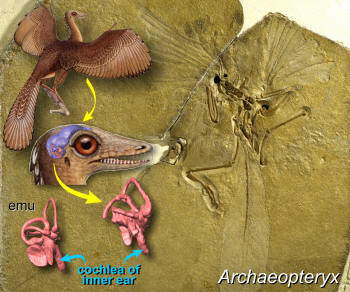|
Lend me your ears. Using inner ear
structure to deduce hearing capability and behavior. The
inner ear is a pretty useful little organ in that it provides
our sense of balance or equilibrium and helps coordinate eye
movements, but, of course, ears also are for hearing. The
cochlea is the hearing portion of the inner ear, and so
information about its size or shape can shed light on hearing
capabilities, as well as other behaviors. The inner ear is
buried deep within t he
skull, and so CT scanning was used to peer inside the skulls of
59 species of modern reptiles and birds. From these CT data, the
inner ears were visualized in 3D, and various measurements of
the cochlea were made. These measurements were then compared to
a variety of hearing parameters and other biological attributes
of the modern species. It turned out that the dimensions of the
cochlea indeed relate to hearing frequency range and what
frequencies are heard best, but, more surprisingly, also relate
to complexity of vocalizations, sociality or living in large
groups, and maybe even, in very general terms, preferred
habitats. Armed with this information gleaned from the modern
realm, attention was turned to some fossil birds and, in
particular, Archaeopteryx, the oldest known bird. The
145-million-year-old fossils of Archaeopteryx have been known
since Darwin’s time, when it quickly was heralded as an
important “missing link,” because it combined birdlike feathers
and wishbone with the teeth and long tail of a small dinosaur.
CT scans of Archaeopteryx reveal that its cochlea is much more
similar to that of modern birds, and that its hearing
capabilities were much like those of modern emus (which is not
particularly a compliment). This study opens the door for future
research into other extinct animals, such as the dinosaurian
relatives of birds, providing the prospects for even more
refined estimates of dinosaur behavior and ecology he
skull, and so CT scanning was used to peer inside the skulls of
59 species of modern reptiles and birds. From these CT data, the
inner ears were visualized in 3D, and various measurements of
the cochlea were made. These measurements were then compared to
a variety of hearing parameters and other biological attributes
of the modern species. It turned out that the dimensions of the
cochlea indeed relate to hearing frequency range and what
frequencies are heard best, but, more surprisingly, also relate
to complexity of vocalizations, sociality or living in large
groups, and maybe even, in very general terms, preferred
habitats. Armed with this information gleaned from the modern
realm, attention was turned to some fossil birds and, in
particular, Archaeopteryx, the oldest known bird. The
145-million-year-old fossils of Archaeopteryx have been known
since Darwin’s time, when it quickly was heralded as an
important “missing link,” because it combined birdlike feathers
and wishbone with the teeth and long tail of a small dinosaur.
CT scans of Archaeopteryx reveal that its cochlea is much more
similar to that of modern birds, and that its hearing
capabilities were much like those of modern emus (which is not
particularly a compliment). This study opens the door for future
research into other extinct animals, such as the dinosaurian
relatives of birds, providing the prospects for even more
refined estimates of dinosaur behavior and ecology
Image caption: The cochlea of the inner ear of the
145-million-year-old bird
Archaeopteryx
can be reconstructed from CT scans of fossils. Based on
comparisons with modern reptiles and birds (such as the emu at
lower left), new insights into such behaviors as vocal
complexity and sociality can now be better understood in extinct
taxa. Courtesy of Witmer & Ridgely, Ohio Univ., and NHM, London. |